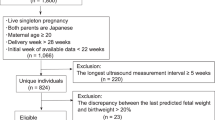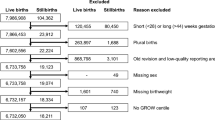Abstract
Reduced birthweight is a marker of pathologies that impair growth and also decrease survival. However, “fetal growth restriction” remains poorly defined. Assuming that birthweight itself has no causal effect on neonatal mortality, we can estimate the features of pathological fetal growth that would be required to produce the observed pattern of weight-specific mortality. Under the simplest possible scenario, we find that at 39–41 weeks, pathological fetal growth restriction affects only about 0.5% of U.S. births, with a neonatal mortality risk up to 220-fold. This surprising concentration of pathology among a tiny subset of babies would account for roughly half of neonatal deaths at term. Moreover, the prevalence of these pathological births appears to have remained relatively stable over recent decades, even as neonatal mortality in the U.S. has declined by 90%. In our model, the decline has been driven by the reduction in baseline mortality (i.e., mortality among babies unaffected by growth pathologies), while the relative risk of death among pathologically grown infants has apparently remained stable. Fetal growth restriction is conventionally regarded as common and preventable. In contrast, our observations suggest that pathological fetal growth is rare and constant over time, perhaps the result of unpreventable stochastic errors in embryonic development. Public health strategies may be more effective by setting aside attempts to increase birthweight, and focusing instead on the discovery and support of factors (unrelated to birthweight) that have produced the striking reductions in neonatal mortality over time.
Similar content being viewed by others
References
Wilcox AJ, Skjaerven R. Birth weight and perinatal mortality: the effect of gestational age. Am J Public Health. 1992;82(3):378–82.
Wilcox AJ. On the importance—and the unimportance— of birthweight. Int J Epidemiol. 2001;30(6):1233–41.
Mandy GT. Infants with fetal (intrauterine) growth restriction. UpToDate. Accessed 7 April 2022.
Galbraith RS, Karchmar EJ, Piercy WN, Low JA. The clinical prediction of intrauterine growth retardation. Am J Obstet Gynecol. 1979;133(3):281–6.
Zeve D, Regelmann MO, Holzman IR, Rapaport R. Small at birth, but how small? The definition of SGA revisited. Horm Res Paediatr. 2016;86:357–60.
Basso O, Wilcox AJ, Weinberg CR. Birth weight and mortality: causality or confounding? Amer J Epidemiol. 2006;164(4):303–11.
Basso O, Wilcox AJ. Intersecting birth weight-specific mortality curves: solving the riddle. Amer J Epidemiol. 2009;169(7):787–97l.
DHEW Publication No (HSM). 72-1056, “A study of infant mortality from linked records: Comparison of neonatal mortality from two cohort studies, United States, January-March 1950 and 1960,” 1972.
US data from. 2005-15 were downloaded from publicly available vital statistics files https://www.cdc.gov/nchs/data_access/vitalstatsonline.htm
Cortese M, Moster D, Wilcox AJ. Term birth weight and neurodevelopmental outcomes. Epidemiology. 2021;32(4):583–90.
Doan T, Briffa J, Phillips A, Leemaqz S, Burton R, Romano T, Bianco-Miotto T. Epigenetic mechanisms involved in intrauterine growth restriction and aberrant kidney development and function. J Dev Origins Health Disease. 2021;12(6):952–62.
Gaume RE, Heitmann RJ, Luizzi J, Pier BD. Large for gestational age after frozen embryo transfer: an evaluation of the possible causes for this relationship. F&S Reviews. 2021;2(1):21–31.
Yang Q, Chen H, Correa A, Devine O, Mathews TJ, Honein MA. Racial differences in infant mortality attributable to birth defects in the United States, 1989–2002. Birth Defects Res A Clin Mol Teratol. 2006;76(10):706–13.
Hutcheon JA, Riddell CA, Himes KP. A New Approach for classifying fetal growth restriction. Epidemiology. 2021;32(6):860–7.
Ferguson KK, Sammallahti S, Rosen E, van den Dries M, Pronk A, Spaan S, et al. Fetal growth trajectories among small for gestational age babies and child neurodevelopment. Epidemiology. 2021;32:664–71.
Bommarito PA, Cantonwine DE, Stevens DR, Welch BM, Davalos A, Zhao S, McElrath TF, Ferguson KK. An application of group-based trajectory modeling to define fetal growth phenotypes among SGA births in the LIFECODES Fetal Growth Study.AJOG in press.
Basso O, Wilcox AJ. Might rare factors account for most of the mortality of preterm babies? Epidemiology 22(3):320-7l 2011.
Gagliardi L, Rusconi F, Da Frè M, et al. Pregnancy disorders leading to very preterm birth influence neonatal outcomes: results of the population-based ACTION cohort study. Pediatr Res. 2013;73(6):794–801.
Cairncross ZF, Chaput KH, McMorris C, Ospina M, Brown HK, Metcalfe A. Roles of the underlying cause of delivery and gestational age on long-term child health. Paediatr Perinat Epidemiol. 2020;34(3):331–40.
Moster D, Lie RT, Markestad T. Long-term medical and social consequences of preterm birth. N Engl J Med. 2008;359(3):262–73.
Ellis WS. Mortality and Birth Weight in Philadelphia Blacks: an example of stabilizing selection. Am J Phys Anhtrop. 1973;38(14):145–50.
Haig D. Meditations on birth weight: is it better to reduce the variance or increase the mean? Epidemiology 14(4):490-2; 2003.
Carlsen E, Magnus MC, Gjessing H, Omsland TK, Kravdal Ø, Magnus P, Håberg S, Wilcox AJ. Stumped by the Hump: the curious rise and fall of norwegian birthweights, 1991–2007. Epidemiol. 2020;31(4):587–94.
Hernandez-Diaz S, Schisterman EF, Hernan MA. The birth weight “paradox” uncovered? Amer J Epidemiol. 2006;164(11):1115–20.
Schisterman EF, Hernández-Díaz S. Invited commentary: simple models for a complicated reality. Am J Epidemiol. 2006;164(4):312–4.
Ganzevoort W, Thilaganathan B, Baschat A, Gordijn SJ. Fetal growth and risk assessment: is there an impasse? Am J Obstet Gynecol. 2019;220(1):74–82.
Wilcox AJ, Cortese M, McConnaughey DR, Moster D, Basso O. The limits of small-for-gestational-age as a high-risk category. Eur J Epidemiol. 2021;36(10):985–91.
Kamphof HD, Gordijn SJ, Ganzevoort W, Verfaille V, Offerhaus PM, Franx A, Pajkrt E, de Jonge A, Henrichs J. Associations of severe adverse perinatal outcomes among continuous birth weight percentiles on different birth weight charts: a secondary analysis of a cluster randomized trial. BMC Pregnancy Childbirth. 2022;22(1):375–85.
Yang L, Waldhoer T, Re. The limits of small-for-gestational-age as a high-risk category. Eur J Epidemiol. 2022;37:305–6.
Villar J, Altman D, Purwar M, Noble J, Knight H, Ruyan P, Cheikh Ismail L, Barros F, Lambert A, Papageorghiou A, Carvalho M, Jaffer Y, Bertino E, Gravett M, Bhutta Z, Kennedy S, for the International Fetal. and Newborn Growth Consortium for the 21st Century (INTERGROWTH-21st). The objectives, design and implementation of the INTERGROWTH-21st Project. BJOG 120 (Suppl. 2): 9–26l; 2013.
Buck Louis GM, Grewal J, Albert PS, Sciscione A, Wing DA, Grobman WA, Newman RB, Wapner R, D’Alton ME, Skupski D, Nageotte MP, Ranzini AC, Owen J, Chien EK, Craigo S, Hediger ML, Kim S, Zhang C, Grantz KL. Racial/ethnic standards for fetal growth: the NICHD Fetal Growth Studies. Am J Obstet Gynecol 213(4):449.e1-449.e41; 2015.
United Nations Children’s Fund (UNICEF). World Health Organization (WHO). UNICEF-WHO Low birthweight estimates: levels and trends 2000–2015. Geneva: World Health Organization; 2019.
US Centers for.Disease Control MMWR6(1);1–4,9–10; January 16, 1987
Acknowledgements
We thank Drs. Clarice Weinberg and Angel Davalos for mathematical consultation, and Dr. D. Robert McConnaughey for accessing data and creating the figures. Valuable suggestions on earlier drafts of this paper were provided by Drs. Donna Baird, Marianna Cortese, Kelly Ferguson, JW Ganzevoort, Sanne Gordijn, David Haig, Siri Haberg, Quaker Harmon, Jennifer Hutcheon, Mark Klebanoff, Liv Kvalvik, Rolv Terje Lie, Dag Moster, David Savitz, Rolv Skjaerven, Jon Snowden, Ezra Susser, and Clarice Weinberg.
Funding
This project was supported in part by the Intramural Program of the National Institute of Environmental Health Sciences, NIH. Both authors are independent from funders and had full access to all of the data (including statistical reports and tables) in the study. Both authors take responsibility for the integrity of the data and the accuracy of the data analysis.
Author information
Authors and Affiliations
Contributions
Both authors meet the Vancouver criteria for authorship and have approved this version of the manuscript.
Corresponding author
Ethics declarations
Ethics approval
All data used in this paper are publicly accessible. No IRB approval was necessary.
Additional information
Publisher’s Note
Springer Nature remains neutral with regard to jurisdictional claims in published maps and institutional affiliations.
Electronic supplementary material
Below is the link to the electronic supplementary material.
Rights and permissions
Springer Nature or its licensor (e.g. a society or other partner) holds exclusive rights to this article under a publishing agreement with the author(s) or other rightsholder(s); author self-archiving of the accepted manuscript version of this article is solely governed by the terms of such publishing agreement and applicable law.
About this article
Cite this article
Wilcox, A.J., Basso, O. Inferring fetal growth restriction as rare, severe, and stable over time. Eur J Epidemiol 38, 455–464 (2023). https://doi.org/10.1007/s10654-023-00985-7
Received:
Accepted:
Published:
Issue Date:
DOI: https://doi.org/10.1007/s10654-023-00985-7









